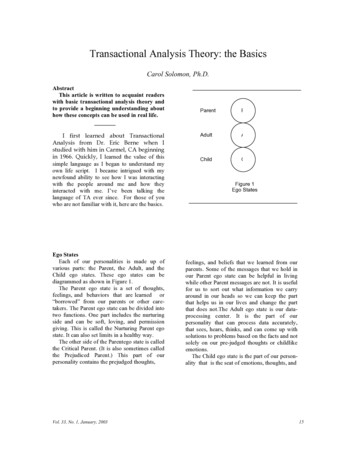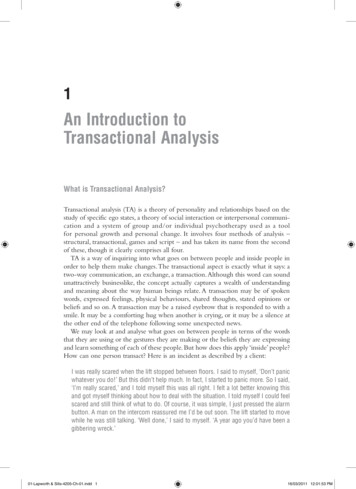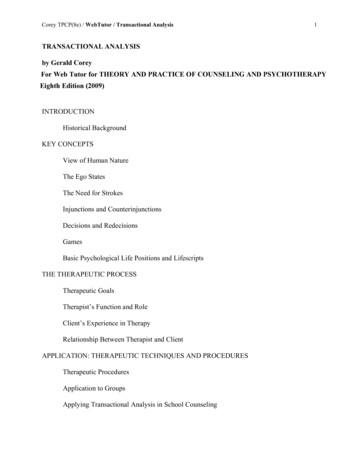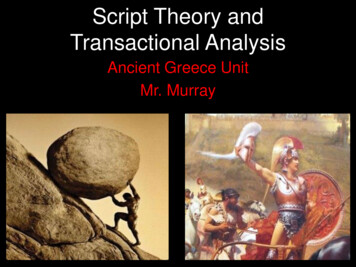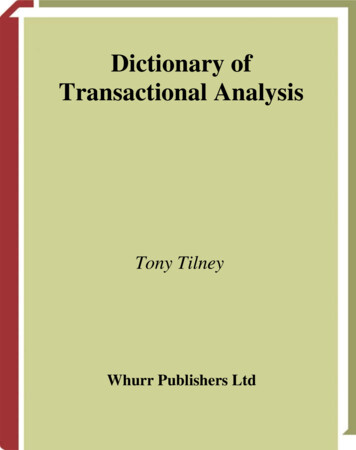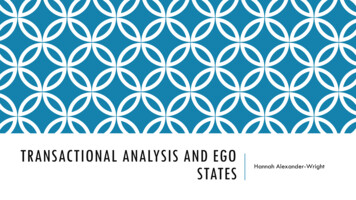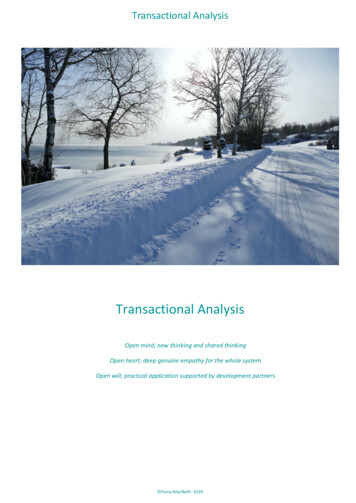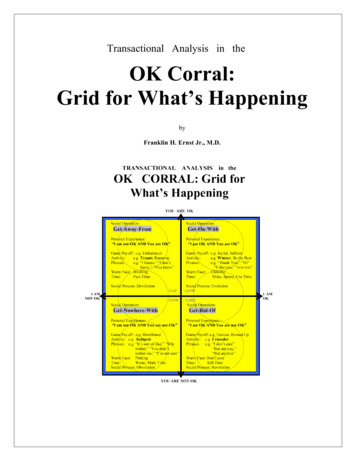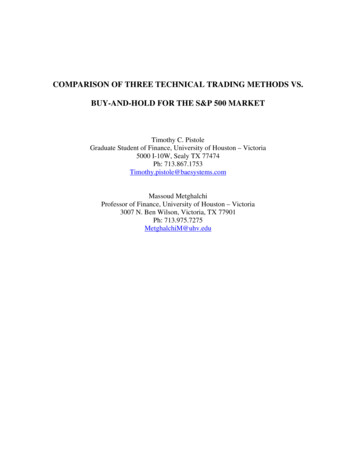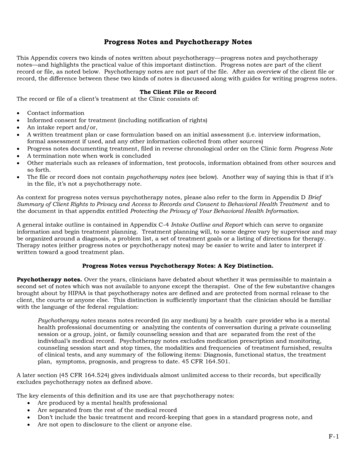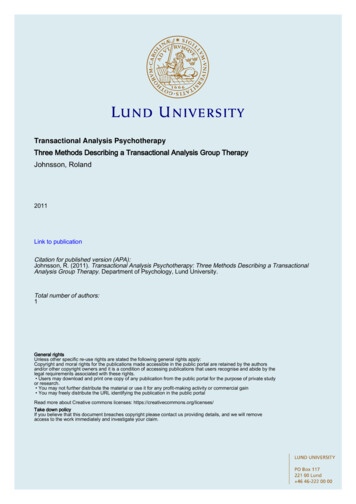
Transcription
Transactional Analysis PsychotherapyThree Methods Describing a Transactional Analysis Group TherapyJohnsson, Roland2011Link to publicationCitation for published version (APA):Johnsson, R. (2011). Transactional Analysis Psychotherapy: Three Methods Describing a TransactionalAnalysis Group Therapy. Department of Psychology, Lund University.Total number of authors:1General rightsUnless other specific re-use rights are stated the following general rights apply:Copyright and moral rights for the publications made accessible in the public portal are retained by the authorsand/or other copyright owners and it is a condition of accessing publications that users recognise and abide by thelegal requirements associated with these rights. Users may download and print one copy of any publication from the public portal for the purpose of private studyor research. You may not further distribute the material or use it for any profit-making activity or commercial gain You may freely distribute the URL identifying the publication in the public portalRead more about Creative commons licenses: https://creativecommons.org/licenses/Take down policyIf you believe that this document breaches copyright please contact us providing details, and we will removeaccess to the work immediately and investigate your claim.LUNDUNIVERSITYPO Box11722100Lund 46462220000
TRANSACTIONAL ANALYSISPSYCHOTHERAPYThree Methods Describing aTransactional Analysis Group TherapyRoland JohnssonLUND UNIVERSITYDepartment of Psychology 2011
Roland Johnsson, 2011Doctoral dissertationDepartment of Psychology, Lund UniversityBox 213, SE-22100 Lund, SwedenISBN 978-91-7473-185-9Cover picture: I am sailing my boat Blue Pram II in the Sound (Öresund).Photo taken by my son in law Martin Bergström in early autumn 2011.A sailing boat symbolizes freedom. You loosen the moorings, set your sails, decide thecourse, and check weather and navigation and then you go where you want to go.Jean Paul Sartre says, “Freedom is what you do with what has been done to you”Psychotherapy is to help people get emotional and cognitive awareness about themselves sothey can free themselves from their self-limiting patterns and bonds, leave their unsecureharbour and set new course in life.Printed by Printus Boktryckeri, Malmö 2011
LIST OF STUDIESThis doctoral dissertation is based on the following three studies, which will be referred to inthe text by their Roman numerals:Study IJohnsson, R. Client Assessment in Transactional Analysis – A Study of theReliability and Validity of the Ohlsson, Björk and Johnsson ScriptQuestionnaire. International Journal for Transactional Analysis Research,Vol. 2, No. 2, July 2011Electronic version at http://www.ijtar.org/article/view/8943Study IIJohnsson, R. Transactional Analysis as psychotherapy method – A DiscourseAnalytic study. International Journal for Transactional Analysis Research,Vol. 2, No 2, July 2011Electronic version at http://www.ijtar.org/article/view/8942Study IIIJohnsson, R. and Stenlund, G. The affective dimension of alliance inTransactional Analysis psychotherapy, International Journal for TransactionalAnalysis Research,Vol. 1, No. 1, July 2010Electronic version at http://www.ijtar.org/article/view/8943
AbstractThe overall aim of the present thesis was to enhance and revive the practical understanding ofthe active ingredients in Transactional Analysis Psychotherapy (TA) and to define and laydown elements of TA, which makes it a distinct and replicable method of treatment.The thesis includes three empirical studies of a videotaped one-year long TA Group Therapywith 10 clients. Three different key areas of Transactional Analysis have been investigatedwith support of three different approaches. These are: Diagnosis/ Client assessment withTA s Script Analysis made as a reliability study (Study I), Identification of differentcomponents in TA s psychotherapy method with the use of Discourse Analysis (Study II) andthe Therapeutic Alliance studied with a psychodynamic approach, using the CCRT method(Luborsky, 1990, 1998) and the Plan – Diagnosis method (Weiss and Sampson, 1986) (StudyIII).The average result in Study I shows a ”moderate” reliability in analysing central conflictmotives (the overall Script) in the client’s life situation. More specific Script componentswere given a “fair” reliability, like “primary injunction from father”, “racket feeling”,“escape-hatch”, “driver from father” and “driver from mother”. Conflictual motives withfixed alternatives showed higher reliability than those formulated freely by the assessors.There was no clear stability over time.The results in Study II indicate that with ”certain” reliability the studied therapy contains thecategories that have been identified as parts of TA psychotherapy. In ranking the seven maincategories you can find “moderate” reliability for the two categories “feeling contact” and“contract”. Six of the 42 sub-categories gave similar result where the techniques “talk to theparent projection” and “active use of TA terminology” has the highest value. The other fourwere “making feeling statements”, “mutual negotiation”, “refer to contract” and “discrepancyin body language”. One intervention, “mutual negotiation”, with moderate reliability could beidentified as “TA typical”The result in Study III showed, both through quantitative and qualitative analysis that theaffective dimension was given larger space than you can expect from what the TA methodprescribes, where contract and other rational techniques and attitudes are stressed.
ACKNOWLEDGEMENTSTwenty-two years is a long time for giving birth to this awaited creation. Many people havesupported me in this process. It started with the 10 clients in the TA therapy group, who gavetheir consent to the research project. In the group were also Torgny Schunnesson and LarsWestman. Two involved professional filmmakers who recorded and produced the one-yearlong videotaped therapy.In the department of psychology my first supervisor professor Alf Nilsson inspired me, withhis enthusiasm and broad knowledge, to find new paths in psychology. After retiringprofessor Mats Fridell became my supervisor. Over the years I have been impressed by hispersistent positive attitude and open creative mind in solving problems. He helped me tocombine my clinical experience with a research perspective. Lecturer Gunvor Stenlund aclose friend and engaged researcher assisted me patiently with Study III about the affectivedimension of alliance. Andreas Josefsson a psychology student and independent observer inStudy II helped me with his good knowledge in computer work to structure the codings of the42 categories. Eva Henriksson has kindly and smoothly supported me in the final format andlayout of the dissertation manuscript.Julie Hay, editor of the International journal of Transactional Analysis (www.ijtar.org), hasgiven me helpful advice in forming the final versions of my three articles.Morten Hesse who is Assistant professor at University of Aarhus generously provided mewith statistical calculations both in Study I and II.My two colleagues Thomas Ohlsson and Annika Björk, with whom I share a private practicecalled Institutet för Livsterapi (Institute for Life therapy), have followed my research ambitions from the start. They have supported me both in setbacks and success. In Study I theyassisted me by being independent observers. They have read and reviewed articles, givenhelpful feedback and a lot of emotional backing. Thanks co-workers!Annika Björk is also my lovely wife and together with my two daughters Marina and Petraand their families I have received invaluable personal encouragement, for which I am verygrateful.Malmö, November 2011Roland Johnsson
CONTENTSINTRODUCTION . 5Transactional Analysis theory, method and history . 5An overview . 5Ego states . 7Transactional Analysis proper . 10Game Analysis . 11Script Analysis . 13Treatment . 21Psychotherapy research . 24Effectiveness and process research . 24Effectiveness studies in Transactional Analysis Psychotherapy . 27PROJECT STRUCTURE AND AIM . 31METHOD . 33Selection . 33Study material . 32Therapist . 35Clients . 35Description of group clients . 35Instruments, codings and statistical processing. 38Study I . 38Study II. 38Study III . 39
SUMMARY OF RESULTS . 41Study I . 41Study II . 42Study III . 42DISCUSSION . 45Main result . 45Methodological considerations . 46Reliability and validity . 47Discussion of results . 50Concluding remarks . 53SUMMARY IN SWEDISH/SVENSK SAMMANFATTNING . 55REFERENCES . 57APPENDIX . 66APPENDED STUDIES . 69STUDY I . 73STUDY II . 91STUDY III . 109
Transactional Analysis PsychotherapyINTRODUCTIONTransactional Analysis Psychotherapy (TA) is an integrative, relational, psychodynamictherapy grounded in humanistic psychology. TA is described in the International Transactional Analysis Association, ITAA s training and examinations handbook (ITAA website,2011) as “a theory of human personality, a theory of social behaviour, and a comprehensivesystem of psychotherapy”.TA was introduced in the late 1950 s by the Canadian/American psychiatrist Eric Berne(1910 – 1970), who founded the basic ideas of the theory and method. From Berne’s conceptualisation and form of therapy, TA has developed and changed in different directions.One direction is the Redecision Therapy, created by Bob and Mary Goulding (1976, 1979).The one-year long Transactional Analysis group therapy studied in this dissertation has itsmain reference in this with Gestalt Therapy (Perl’s, 1969, 1973) integrated form.Three different parts of Transactional Analysis have been investigated with support ofthree different approaches. These are:Diagnosis/ Client assessment with TA s Script Analysis as a reliability study (Study I),Identific
Transactional Analysis Psychotherapy (TA) is an integrative, relational, psychodynamic therapy grounded in humanistic psychology. TA is described in the International Trans-actional Analysis Association, ITAA s training and examinations handbook (ITAA website, 2011) as “a theory of human personality, a theory of social behaviour, and a comprehensive system of psychotherapy”. TA was .

